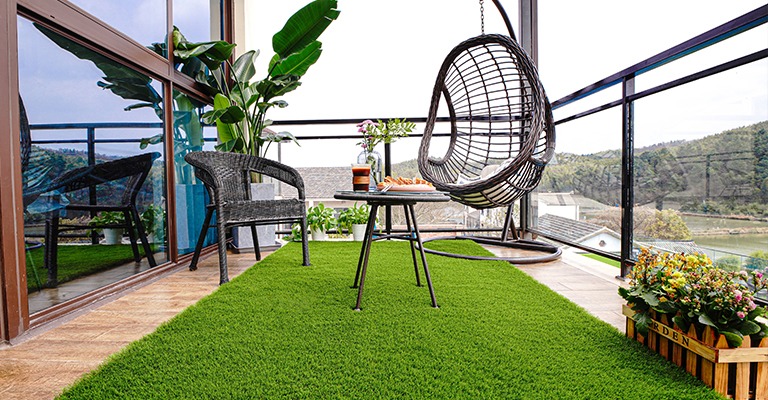Delve Into the Environmental Advantages of Opting for Synthetic Grass Solutions
The adoption of fabricated turf remedies presents a compelling possibility to address pushing environmental obstacles. By substantially lowering water usage and lessening the application of hazardous chemicals, these options not only advertise lasting landscaping yet also shield regional ecosystems.
Water Preservation Conveniences
One of the most substantial benefits of fabricated grass is its ability to conserve water. In comparison, fabricated grass does not require watering, dramatically minimizing the overall demand for water resources.
By removing the demand for normal watering, synthetic grass contributes to sustainable landscape methods and aids mitigate the environmental effect of too much water intake. In addition, the conservation of water reaches the decrease of drainage, which can cause dirt erosion and river contamination.
Furthermore, the installment of synthetic turf allows districts and house owners to allot water sources a lot more successfully, concentrating on essential usages such as drinking water and farming. The shift towards synthetic grass not only promotes liable water use but likewise lines up with wider environmental objectives aimed at maintaining natural sources.
As communities progressively focus on sustainability, the water preservation advantages of synthetic grass provide a compelling case for its fostering in residential and industrial landscaping tasks.
Minimized Chemical Usage
The shift to synthetic grass considerably lowers the dependence on chemical treatments generally utilized in natural lawn upkeep. Traditional grass management typically includes the application of pesticides, plant foods, and herbicides to advertise development and control pests. These chemicals can pose threats to human wellness, neighborhood wild animals, and the environment, adding to soil and water contamination.
In comparison, artificial grass gets rid of the demand for these harmful materials. When mounted, it calls for minimal upkeep, mostly containing routine cleaning and irregular infill replenishment. This reduction in chemical use not just benefits the prompt setting but additionally contributes to wider eco-friendly security. By reducing the release of synthetic compounds into the ecological community, synthetic grass promotes healthier dirt and water supply.
In addition, the absence of chemical runoff connected with synthetic grass installations aids protect local rivers from air pollution, supporting water life and preserving biodiversity. Arizona turf. As neighborhoods progressively prioritize sustainable methods, going with synthetic grass provides a feasible service that aligns with ecological conservation goals. Through this shift, homeowner can delight in lush eco-friendly rooms without endangering eco-friendly health and wellness, leading the way for an extra sustainable future
Reduced Carbon Footprint

Moreover, the setup this contact form of synthetic grass can result in considerable water conservation. Natural grass need considerable quantities of water for watering, which not only contributes to the carbon impact related to water removal and treatment yet likewise strains regional water resources. In comparison, synthetic grass needs marginal upkeep, needing no watering, thus substantially lowering water usage and its associated power costs.
Additionally, the longevity of artificial grass adds to its lower carbon effect. With a life-span of approximately 15 years or even more, the demand for frequent replacements is reduced, causing much less waste and reduced energy usage in manufacturing and taking care of typical turf options. Generally, fabricated grass offers a sustainable alternative for eco aware landscaping.
Habitat Preservation
Environment conservation is a vital consideration in the debate over landscaping selections, especially when contrasting synthetic grass to natural yard. Natural yard lawns typically require extensive maintenance, including making use of pesticides, plant foods, and herbicides, which can detrimentally impact local ecological communities. These chemicals can seep into the soil and waterways, hurting indigenous plants and fauna and interfering with regional environments.
Synthetic lawn eliminates the need discover this for harmful chemicals, thus protecting neighboring wild animals and keeping the stability of surrounding ecosystems. The installation of artificial lawn can lead to the conversion of former grass locations right into even more biodiverse landscapes, such as pollinator yards or indigenous plant locations, which can sustain regional wildlife.
Inevitably, the shift to synthetic turf not only preserves water and minimizes maintenance efforts yet likewise promotes a much more unified connection in between human tasks and the natural setting, advertising habitat conservation at the same time.
Long-Term Sustainability
Long-term sustainability is an important element in examining the benefits of synthetic turf over standard lawn yards. Among one of the most considerable advantages of synthetic grass is its toughness; it can last as much as 15-20 years with minimal maintenance, whereas natural yard requires constant reseeding and replacement. This long life decreases the need for continuous sources, such as water, fertilizers, and pesticides, which are necessary for maintaining a healthy turf lawn.
In addition, synthetic grass adds to a reduction in carbon exhausts connected with yard care devices. Typical lawns usually require gas-powered mowers, leaners, and blowers, every one of which add to air pollution. Phoenix turf companies. In comparison, synthetic lawn removes the need for such equipment, advertising a cleaner environment
Moreover, the production of artificial turf progressively utilizes recycled materials, improving its sustainability profile. As makers take on green techniques, the environmental impact of man-made grass continues to diminish.

Final Thought
The adoption of synthetic grass options offers significant ecological advantages, including substantial water preservation, minimized reliance on damaging chemicals, and a reduced carbon impact. Furthermore, synthetic grass aids in protecting all-natural environments by lessening land disruption and promoting long-term sustainability through making use of resilient products. Collectively, these aspects underscore the potential of synthetic grass to contribute positively to ecological health and wellness and use a viable choice to typical landscape design methods in an increasingly resource-conscious globe.
In comparison, man-made turf does not require watering, significantly reducing the general need for water sources. By decreasing the launch of artificial substances into the ecological community, artificial lawn advertises healthier soil and water systems.
In addition, the setup of fabricated grass can result in substantial water conservation. In contrast, artificial grass requires marginal maintenance, requiring no watering, thereby dramatically decreasing water use read this and its linked energy prices.
